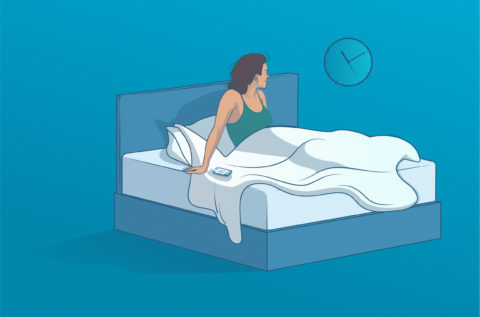Lucid dreaming, or conscious dreaming, is a kind of aware way of dreaming that mostly happens during REM sleep. In this state, you can sometimes wholly or partly determine the narrative. During a lucid dream, the frontal lobe of the brain is activated, allowing you to control the dream. This ability is common among young children, but some retain it even in adulthood. And some can even learn to practice it. But are there any real benefits? Or can be lucid dreaming potentially dangerous?
Jump directly to: 6 potential benefits of lucid dreaming
How to lucid dream: is it really possible?
It wasn’t until the early 1980s that American scientists finally succeeded in presenting scientific proof that this dream phenomenon really exists. They started to induce lucid dreams using different techniques, which may indicate that lucid dreaming is a skill that can be developed with practice and training:
- MILD (mnemonic induction of lucid dreams): This technique involves setting an intention to remember that you are dreaming before going to sleep and repeating a phrase such as “next time I’m dreaming, I want to remember that I’m dreaming.”
- Reality testing: This involves regularly checking your surroundings during the day to see if you are awake or dreaming. By doing this regularly, you will be more likely to recognize when you are in a dream state.
- WILD (wake-induced lucid dream): This technique involves staying awake for a period of time after going to bed, and then directly entering a dream state while still maintaining consciousness.
- WBTB (Wake back to bed): here, individuals try to wake up in the middle of the night to go back to sleep after a certain amount of time.
- Keeping a dream journal: Writing about your dreams each morning can help you become more aware of your dream experiences and increase your chances of becoming lucid in a dream.
- External stimulation during REM sleep: this involves external stimulation, like flashing lights, during the REM sleep stage so that the individual will include it in their dream.
It’s also important to note that lucid dreaming can be affected by certain medications, sleeping disorders and medical conditions.
6 potential benefits of lucid dreaming
Although lucid dreaming has been extensively researched, there are still many unknown aspects of the phenomenon. Dr. Frida Rångtell of the Department of Neuroscience at Uppsala University reveals that this ability to dream turns out to be both more complex and more versatile than expected. However, science suggests different aspects of lucid dreaming that could be potentially beneficial:
1. Improved problem-solving skills
Lucid dreaming allows individuals to actively participate in their dreams and manipulate the dream environment, which can lead to improved problem-solving skills in waking life. A study conducted by the University of Lincoln in 2014 revealed that individuals who experience lucid dreams more frequently perform better on cognitive tasks requiring insight and problem-solving abilities while they are awake.
2. Increased self-awareness
Lucid dreams can increase self-awareness by allowing individuals to observe their thoughts and emotions in a dream state, which can lead to a deeper understanding of oneself. Research has found that a brain region known for self-reflection is larger in lucid dreamers, potentially meaning that lucid dreamers are better at self-reflection. The study also suggests that there may be a relationship between lucid dreaming and metacognition or thought monitoring, and that these abilities share neural networks.
3. Reduced nightmares
Lucid dreaming can be used as a tool to confront and overcome fears or traumatic experiences that may manifest in nightmares and can help later on if lucidity can’t be fully achieved. Dr. Frida Rångtell comments: “Lucid dreaming can be a very helpful tool to deal with nightmares. Being lucid during a nightmare can help you realize that it’s just a dream and could maybe even help you change the ending.”
4. Enhance creativity and cognitive learning
Conscious dreaming could be also used as a tool to explore new ideas and stimulate creativity. French neurologist Professor Isabelle Arnulf recently discovered that her narcolepsy patients tend to become more creative than other people while sleeping. In addition, she could see that these kinds of dreams tend to increase the individual’s creativity level. The research team compared the creativity level of more than 150 narcolepsy patients with the same number of people without narcolepsy. The study revealed that people with narcolepsy scored far higher in creativity.
However, Dr. Frida Rångtell warns: “we still need more research to figure out the link between lucid dreaming and creativity. There seems to be a connection between REM sleep, the sleep stage where it’s common to experience vivid dreams, and creativity. If you could learn to take control of your dreams during REM sleep, perhaps that could affect you in different ways even when you are awake”.
Regarding how this practice can help cognitive learning, she adds: “Some studies suggest that if you dream about something that you just learned while you were awake, that can make you remember more of it the day after. As far as I know, we still do not know if lucid dreams could have similar effects – if you are lucid dreaming and decide to dream about that tricky math problem you had while studying, could that help you to find the solution on next day’s exam? If that would be the case, practicing lucid dreaming could potentially be very valuable when learning new things and solving social dilemmas.”
5. Improved emotional regulation
This practice can also be used to practice emotional regulation in a safe, dream environment, which can lead to improved emotional regulation in “waking” life. In other words, the control experienced during a lucid dream can be felt while awake and promote feelings of empowerment and wish fulfillment. This can serve as a form of therapy for individuals with stress and anxiety and can be useful for inner work or other healing purposes.
6. Sports performance enhancement
Some research indicates that lucid dreaming could be used to improve physical skills and sports performance. A 2015 study found that practicing a physical activity in lucid dreaming can actually boost waking performance – the same part of the brain is activated whether you visualize the movements while awake or perform them during a lucid dream. Another study observing the link between lucid dreaming and athletic performance found that those who experienced the phenomenon improved their speed compared to other groups, even though there was no statistically significant difference between groups.
Is lucid dreaming dangerous?
While more research on the potential benefits of lucid dreaming is needed, sleep experts point out some of the risks to consider when trying to engage in this practice:
- Sleep disruption: “Keep in mind that lucid dreaming could possibly be disruptive of your sleep. And you don’t intentionally want to mess with your sleep too much”, says Dr. Frida Rångtell. It’s not clear yet whether the “consciousness” that characterizes lucid dreams leads to restless sleep and lower sleep quality. However, the techniques to induce lucid dreaming can interrupt the natural sleep cycle, which results in disrupted and fragmented sleep, and consequently, may rise the risk of physical and mental health issues.
- Psychological distress: this kind of dream can be emotionally taxing, as people may confront their deepest fears and anxieties during their lucid dream. This can lead to psychological distress and emotional turmoil. Additionally, some people may become dependent on lucid dreaming as a form of escapism, which can lead to further psychological problems.
- Reality confusion: Lucid dreaming can blur the line between what is real and what is not, which can lead to confusion and disorientation. It can be particularly problematic for people with mental health conditions such as schizophrenia or dissociative disorders. These individuals may have difficulty distinguishing between reality and their lucid dreams, which can lead to confusion and distress.
- Physical injury: Lucid dreamers may act out their dream scenarios and cause physical harm to themselves. This can happen when lucid dreamers become too excited or emotionally engaged in their dream, causing them to move around or even thrash in their sleep. This can lead to injuries such as sprains, fractures, or bruises.
Lucid Dreaming: Unlocking the potential of the mind during sleep
Lucid dreaming is a unique state of consciousness where the dreamer is aware that they are dreaming and can potentially exert some level of control over the dream. While much is still unknown about lucid dreaming, it is clear that this unique state of consciousness has the potential to change the way we experience our dreams.
However, Dr. Frida Rångtell advises being careful and patient regarding how its real benefits and how it can enhance our lives since it is a rather unexplored scientific area – more research is needed to fully understand its effects and potential therapeutic applications. Overall, lucid dreaming is a fascinating area of study that offers a glimpse into the complexity of the mind and the nature of consciousness.









